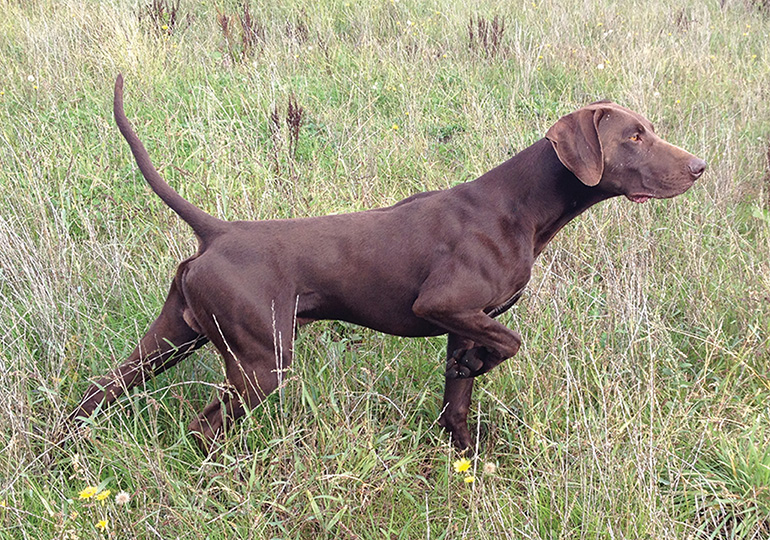German Shorthaired Pointer
Breed Details
Size:
Exercise Requirements:
Grooming Requirements:
20-32 Kg (Approx)
10-12 years

Appearance
The German Shorthaired Pointer is an all-purpose hunting dog and will hunt both feather and fur. Known occasionally as the ‘Kurzaar’, it is a versatile hunter and all-purpose Gundog capable of high performance in the field and water.
A noble, harmonious dog, this breed is made for endurance, power and speed. Its characteristic features are a noble appearance, graceful outlines, a clean-cut head, a well carried tail and a taut, gleaming coat.
The nose is somewhat protruding. Nostrils sufficiently wide, broad and mobile. Basically brown, however black in black or black roan dogs. A flesh-coloured or spotted nose is only permissible in dogs with white as a basic colour.
Skin: Close and tight, not wrinkly.
Texture: Short and dense, rough and hard to the touch. Somewhat thinner and shorter on the head and ears, not remarkably longer at the underside of the tail. Should cover the whole body.
Colours are Solid brown, without markings, brown with small white or flecked markings at chest and legs, dark brown roan, with brown head, brown patches or specks. The basic colour of such a dog is not brown mixed with white or white with brown, but the coat shows such an even intensive mixture of brown and white, which results in that kind of inconspicuous exterior of the dog ever so valuable for the practical hunt. At the inner sides of the hind legs, as well as the tip of the tail, the colour is often lighter.
History
The precise origin of the German Shorthaired Pointer is unclear, however it is likely that the German Shorthaired Pointer is descended from a breed known as the German Bird Dog, which itself is related to the Old Spanish Pointer introduced to Germany in the 17th century. It is also likely that various German hound and tracking dogs, as well as the English Pointer and the Arkwright Pointer also contributed to the development of the breed. However, as the first studbook was not created until 1870, it is impossible to identify all of the dogs that went into creating this breed.
Temperament
Both German Shorthaired and Wirehaired Pointers are very loyal and family orientated and are well-suited to being treated as a family member. German Shorthaired Pointers are also gentle, affectionate and even tempered. Alert, biddable and very loyal, they are never fearful.
Care/Grooming
German Shorthaired Pointers, along with other sporting dogs, requires a lot of exercise and space to run. GSPs have a lot of energy, they are one of the most energetic breeds. 3. Therefore if not given the right amount of attention, they can become bored and destructive. The breed does not do well left alone all day, or if relegated to a kennel without plenty of human interaction.
German Shorthaired Pointers are a very clean breed. Their short coat needs very little grooming, just occasional brushing. They typically shed constantly and should be bathed only when needed.
Grooming the ‘wash and wear’ coat is easy. All it takes is a warm bath with a good shampoo and towel dry, taking care to dry the ears and keep them clean. Like all dogs with flop ears, GSP can be prone to ear infections and their ears require regular checking and cleaning.
German Shorthaired Pointers will shed their old coat once a year; at this time, a good groom with a rubber mitt will help the new coat shine through.
Feeding a good quality premium dry food, along with occasional raw meaty bones, will help keep both breeds’ teeth in top shape.
Healthy, well cared for German Shorthaired Pointers will usually live for as long as 10 to 12 years, sometimes longer. Like all dogs, they can be prone to some hereditary disease.
Recognising this, responsible breeders work to reduce the incidence of hereditary problems in their breeding so that they can produce healthy puppies.
The GSPs coat is easy to groom most of the year, requiring only a good once-over with a brush or grooming glove every few days. Although the coat is short, it still sheds' especially at certain times of the year, when more frequent brushing will be needed to remove the loose hairs before they end up all over the house. The hairs can become embedded in fabrics and carpet and hard to get out. An occasional bath (using a gentle shampoo) can help. The ears should be regularly inspected and cleaned, and the nails trimmed short.

